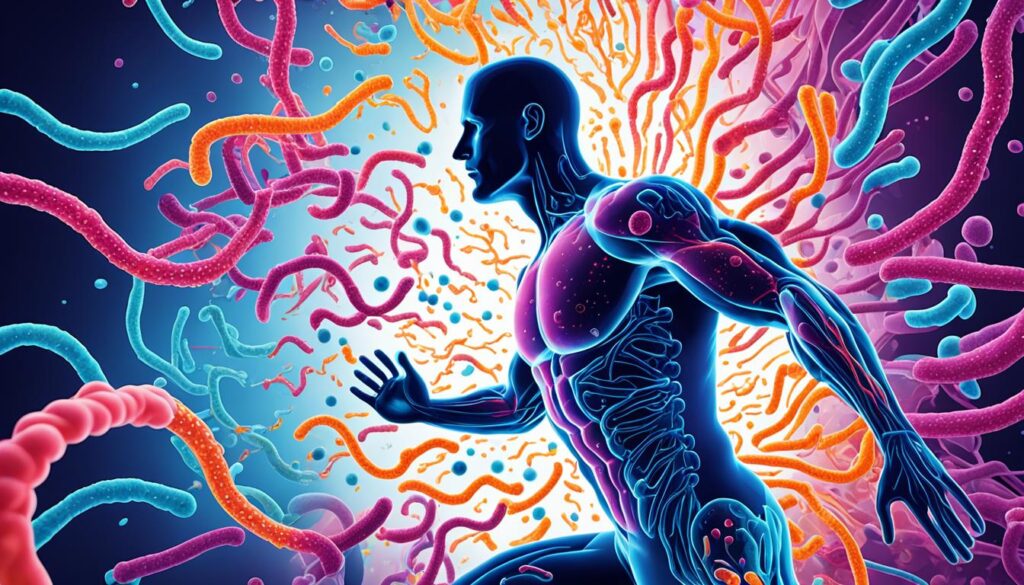Are you tired of the same old workout routines that seem to yield little to no results? Look no further, because this article is your ultimate guide to the best exercises for rapid weight loss. Shedding those stubborn pounds doesn’t have to be a daunting task – with the right approach, you can melt away fat and achieve your fitness goals faster than you ever thought possible1.
From high-intensity interval training (HIIT) to the calorie-burning power of cycling and swimming, we’ll dive into the most effective exercises to help you burn fat and achieve rapid weight loss. Get ready to challenge your body and push your limits, all while seeing the results you crave. Let’s unlock the secrets to shedding pounds and revealing a healthier, more confident you1.
Key Takeaways
- Aim for at least 300 minutes of moderately intense activity per week to lose weight effectively.
- Incorporate HIIT workouts to burn more calories and keep your body in fat-burning mode for up to 24 hours after the workout.
- Cycling, swimming, and strength training can all be highly effective for weight loss, depending on your fitness level and preferences.
- Pilates, yoga, and hiking are great options to improve overall fitness and aid in weight management.
- Climbing stairs regularly can lead to significant weight loss over time.
Intermittent Fasting for Weight Loss
Intermittent fasting is an increasingly popular dietary approach that has gained attention for its potential benefits in weight management. This cyclic pattern of eating alternates between periods of fasting and eating, and studies have indicated that it can be as effective for weight loss as following a daily low-calorie diet2. Adopting a healthy eating pattern on non-fasting days is crucial to ensure long-term success with intermittent fasting.
Popular Intermittent Fasting Methods
Some of the most common intermittent fasting methods include the 16/8 method, the 5:2 diet, and alternate-day fasting. The 16/8 method involves fasting for 16 hours and eating all food within an 8-hour window3. The 5:2 diet allows for normal eating for 5 days and restricts calorie intake to 500-600 calories for the remaining 2 days3. Alternate-day fasting involves alternating between fasting and eating days.
Research has shown that the 16/8 method can be an effective strategy for weight control in adults with overweight or obesity, and it has also been found to have positive effects on glucose metabolism4. The 5:2 diet has been demonstrated to be as effective as daily calorie restriction for weight loss and blood glucose control among those with type 2 diabetes4. Alternate-day fasting has proven weight loss benefits, with participants consuming 37% fewer calories and losing an average of 7.7 pounds (3.5 kg) after alternating between fasting and eating over 4 weeks4.
While intermittent fasting can be an effective weight loss strategy, it’s important to note that the results may vary depending on individual factors, such as age, activity level, and overall health status2. Consultation with a healthcare professional is advisable before making significant changes to one’s eating habits, such as introducing fasting324.
Tracking Diet and Exercise for Weight Loss
Maintaining a consistent record of your dietary intake and physical activity can be a valuable strategy for successful weight loss. Research suggests that regularly tracking your diet and exercise habits can promote behavior changes and increase your motivation to achieve your weight-loss goals5.
Even a simple tool like a pedometer can serve as a useful weight-loss aid by tracking your daily steps and overall physical activity levels5. According to the 2020-2025 Dietary Guidelines for Americans, the average person needs to cut their daily calorie intake by 500 to 750 calories to lose 1 1/2 pounds (0.7 kilograms) per week6.
While diet plays a more significant role in initial weight loss, physical activity is crucial for maintaining weight-loss results over the long term6. The U.S. Department of Health and Human Services recommends that most healthy adults aim for at least 150 minutes of moderate aerobic activity per week or 75 minutes of vigorous aerobic activity per week for overall health benefits6.
To maximize the effectiveness of your weight-loss efforts, consider incorporating compound exercises like squats, deadlifts, and chest presses, which have been shown to tax the body more than isolation exercises7. High-Intensity Interval Training (HIIT) can also be an efficient way to burn calories, with sessions typically lasting 10 to 30 minutes7.
Additionally, activities like water workouts, walking, and cycling can contribute to effective weight loss by challenging your muscles and cardiovascular system7. Even non-exercise activities, known as non-exercise activity thermogenesis (NEAT), can play a significant role in daily energy expenditure and weight management7.
By consistently tracking your diet and exercise, you can gain valuable insights into your habits and make informed adjustments to support your weight-loss journey. Utilizing a variety of weight-loss tools and apps can further enhance your ability to monitor and optimize your progress.
“Consistent tracking of your diet and exercise habits can be a game-changer in achieving sustainable weight loss.”
| Exercise | Calories Burned per Hour (for a 160-lb Person) |
|---|---|
| Running at 5 mph | 606 calories |
| Low-Impact Aerobics | 365 calories |
| Cycling | 400-500 calories |
By integrating these strategies and tools into your weight-loss plan, you can enhance your chances of achieving your goals and maintaining long-term success567.
Mindful Eating for Weight Management
Mindful eating is a practice that involves paying close attention to how and where you consume your food. This approach can not only enhance your enjoyment of meals but may also support weight loss by preventing overeating8. Techniques for mindful eating can effectively treat unhealthy eating behaviors such as emotional and external eating9.
Techniques for Mindful Eating
One of the key techniques for mindful eating is to sit down and focus solely on your meal, avoiding distractions such as television, smartphones, or other electronic devices10. Eating slowly and savoring each bite can help you become more aware of your body’s signals of hunger and fullness, preventing overeating9. Additionally, making conscious food choices and being present during the eating experience can enhance your overall relationship with food.
Mindful eating has been shown to have numerous benefits for weight management8. Studies have found that mindful eating can lead to an average weight loss of 4 pounds (1.9 kg) over a 12-week period8. Mindful eating can also help prevent binge eating, reducing the frequency and severity of these episodes8. Furthermore, mindful eating has been linked to improved feelings of self-awareness, self-acceptance, and self-compassion, which can be crucial for sustainable weight loss8.
In contrast, distractions during meals, such as watching TV or using electronic devices, can lead to increased food consumption10. Emotional eating in response to stress and negative emotions is also a common challenge, but mindful eating techniques can be more effective in emotional regulation than using food as a coping mechanism10.
Incorporating mindful eating practices into your daily routine can be a powerful tool for weight management. By being present and attentive during meals, you can develop a healthier relationship with food, ultimately supporting your weight loss goals9.
“Mindful eating is about being fully present in the moment, savoring each bite, and truly listening to your body’s signals of hunger and fullness.” – Registered Dietitian Nutritionist
Remember, sustainable weight loss is a journey, and mindful eating is one of the many effective strategies you can employ to achieve your goals8. By combining mindful eating with other healthy lifestyle habits, you can unlock the power of your mind-body connection to support lasting weight management9810.
High Protein Breakfast for Weight Loss
Eating a high-protein breakfast can be a game-changer when it comes to weight loss. Protein-rich meals help regulate appetite hormones, leading to increased feelings of fullness and reduced calorie intake throughout the day11. In fact, research has shown that the hormonal effects of a high-protein breakfast can last for several hours11.
When it comes to the best high-protein breakfast ideas, the options are plentiful. Eggs, oats, nut and seed butters, quinoa porridge, sardines, and chia seed pudding are all excellent choices11. These nutrient-dense foods not only provide a satisfying protein punch but also offer other beneficial nutrients like fiber, healthy fats, and complex carbohydrates that can support weight loss efforts11.
| High-Protein Breakfast Idea | Protein Content (per serving) | Preparation Time |
|---|---|---|
| Blackberry Smoothie | 15g | 5 minutes |
| Quick Egg Scramble | 18g | 10 minutes |
| Bagel Breakfast Sandwich | 21g | 15 minutes |
| Egg in Bell Pepper Rings | 17g | 20 minutes |
| Bean Burritos | 19g | 20 minutes |
Incorporating a high-protein breakfast into your daily routine can have numerous benefits for weight loss. Studies have shown that increasing protein intake in the morning can lead to improved food choices, including less refined grains and added sugar12. Consuming 15 to 30 grams of protein at breakfast can also help regulate blood sugar levels and enhance focus and satisfaction in the morning12.
Furthermore, individuals who start their day with 30 to 39 grams of protein have been found to consume 175 fewer calories at lunchtime12. Additionally, increasing protein intake to 40 percent of daily caloric intake can result in burning more calories and fat over 32 hours compared to a standard American diet12.

By incorporating high-protein breakfast options into your weight loss plan, you can take advantage of the numerous benefits, including increased feelings of fullness, improved food choices, and enhanced calorie and fat burning throughout the day1112. Whether you prefer a quick and convenient option or a more elaborate breakfast, there are plenty of delicious and nutritious high-protein breakfast ideas to choose from13.
“Eating a high-protein breakfast is one of the most effective ways to support weight loss and maintain a healthy weight.”
Reduce Intake of Added Sugars and Refined Carbs
Reducing your intake of added sugars and refined carbs can be a game-changer for your weight loss journey. The Western diet is often high in these processed foods, which have been linked to weight gain and other health issues14.
Refined grains, such as white rice, white bread, and regular pasta, are quickly digested and can contribute to a spike in blood sugar and insulin levels14. This can promote fat storage and lead to weight gain. Replacing these processed foods with whole grains, fruits, vegetables, and other nutrient-dense options can support your weight loss efforts14.
In addition, sugar-sweetened beverages, like regular soda and sweetened iced tea, are major sources of added sugars that can pack on the pounds14. One can (12 fluid ounces) of non-diet cola contains 35 grams of carbs, while a small sweetened iced tea drink contains 29.5 grams of carbs14. Fruit juice, though natural, is also considered a simple carb and can contribute to weight gain14.
Processed foods like granola and cereal can also be high in carbs, with a cup of store-bought granola containing around 68 grams of carbs and a cup of Raisin Bran cereal having around 46 grams of carbs14. Even natural sweeteners like honey, with 17 grams of carbs per tablespoon, can add significant carb and sugar content to your diet14.
When dining out, it’s important to be mindful of the carb-heavy sides like potatoes, rice, pasta, or bread that can add 30 or more grams of carbs to your meal14. Opting for more vegetable-based dishes or swapping out refined carbs for lower-carb alternatives can help you stay on track with your weight loss goals14.
By reducing your intake of added sugars and refined carbs, you can support your weight loss efforts and improve your overall health15. Focusing on nutrient-dense, high-fiber foods like vegetables, fruits, and whole grains can help you feel full and satisfied while also providing essential vitamins, minerals, and antioxidants15.
Remember, the key is to make gradual, sustainable changes to your diet rather than drastic restrictions15. Consulting with a healthcare professional or registered dietitian can also help you develop a personalized plan that works best for your individual needs and preferences15.
“Changing your eating habits can be challenging, but the benefits of reducing added sugars and refined carbs are well worth the effort. Your health, energy levels, and waistline will thank you.”
Increase Fiber Intake for Weight Loss
Dietary fiber is an essential component of a healthy, high-fiber diet for weight loss. Fiber-rich foods can increase feelings of fullness and potentially lead to a reduction in calorie intake, making them a valuable tool for weight management16. However, it’s important to note that not all types of fiber are equally effective for weight loss.
Viscous soluble fibers, such as pectins, beta-glucans, psyllium, glucomannan, and guar gum, have been shown to increase feelings of fullness and reduce appetite16. In contrast, a large review study found that psyllium and guar gum, while viscous fibers, are ineffective as weight loss supplements16. On the other hand, glucomannan, a fiber extracted from the konjac root, shows potential for weight reduction in individuals with overweight and obesity16.
Fiber-Rich Foods
Incorporating a variety of fiber-rich foods into your diet can be an effective strategy for weight loss17. Some excellent sources of dietary fiber include:
- Whole-grain breakfast cereals18
- Whole-wheat pasta18
- Whole-grain bread18
- Oats18
- Barley18
- Rye18
- Fruits18
- Vegetables18
- Peas18
- Beans18
- Pulses18
- Nuts18
- Seeds18
Incorporating one high-fiber food into each meal is a good way to utilize fiber for weight loss17. When increasing fiber intake, it is important to stay hydrated as fiber draws water into the stool to aid with digestion17.
While fiber can be a valuable tool for weight loss, it’s important to note that it’s not a magic bullet17. Potential drawbacks of using fiber for weight loss include potential gassiness and bloating if not used to consuming fiber17. It’s essential to gradually increase your fiber intake and stay hydrated to avoid these side effects.
“An estimated 100 trillion bacteria live in the gut, primarily in the large intestine.”16
Observational studies have shown a correlation between a high fiber intake and lower levels of inflammatory markers in the bloodstream16. Additionally, a review of 44 studies indicated that 39% of fiber treatments increased fullness, and 22% reduced food intake16. These findings suggest that incorporating more fiber-rich foods into your diet can be an effective strategy for weight loss.
The Best Exercises for Rapid Weight Loss
When it comes to shedding pounds quickly, regular exercise is a crucial component alongside dietary changes. The best exercises for rapid weight loss target multiple muscle groups, elevate your heart rate, and help you burn a significant number of calories19.
High-Intensity Interval Training (HIIT) is a highly effective workout that involves short bursts of intense exercise followed by periods of rest or lower-intensity activity. HIIT is noted for burning more fat and calories than traditional cardio19. Swimming is another excellent option, as it is a low-impact workout that engages multiple muscle groups in the body, such as arms, legs, and core19.
Yoga is a unique approach that combines breathing exercises, meditation, and physical postures to aid in weight loss. It can help reduce stress and increase body awareness, which are important factors in successful weight management19.
For healthy weight loss, experts recommend incorporating at least 150 minutes per week of moderate aerobic activity or 75 minutes of vigorous aerobic activity20. It is also advised to include strength training exercises that target all major muscle groups two to three times per week20.
Walking briskly for 30 minutes per day, most days of the week, can contribute to weight loss efforts20. Jumping rope can burn roughly 12 calories per minute for an adult weighing 150 pounds, comparable to running at an 8½-minute mile pace20. Kickboxing is a full-body exercise that works the core, legs, and obliques, providing stress relief and promoting better athleticism20. Spinning on a stationary bike is considered a great weight-loss activity targeting major muscle groups like the glutes and hamstrings, helping burn fat across the body20.
Other highly effective exercises for rapid weight loss include chest-to-floor burpees, lunges, barbell squats, barbell bench press, farmer’s walks, sled pulls, and the assault bike21. By incorporating a variety of these activities into your routine, you can create a well-rounded exercise plan that helps you achieve your weight loss goals.
| Exercise | Benefits for Weight Loss | Recommended Intensity/Duration |
|---|---|---|
| High-Intensity Interval Training (HIIT) | Burns more fat and calories than traditional cardio | Short bursts of intense exercise followed by periods of rest or lower-intensity activity |
| Swimming | Low-impact workout that engages multiple muscle groups | 30-60 minutes, several times per week |
| Yoga | Reduces stress and increases body awareness | 2-3 sessions per week, 30-60 minutes each |
| Walking | Moderate aerobic activity that can contribute to weight loss | 30 minutes per day, most days of the week |
| Jumping Rope | Burn 12 calories per minute (for a 150-lb person) | 10-20 minutes per session, several times per week |
| Kickboxing | Full-body exercise that works the core, legs, and obliques | 30-60 minutes per session, 2-3 times per week |
| Stationary Cycling (Spinning) | Targets major muscle groups like the glutes and hamstrings | 30-60 minutes per session, several times per week |
By incorporating a variety of these high-intensity, calorie-burning exercises into your routine, you can maximize your weight loss efforts and achieve rapid, sustainable results192021.
Gut Bacteria and Weight Management
Emerging research suggests that the composition and diversity of gut bacteria may play a crucial role in weight management. The human gut hosts trillions of mutually beneficial microbes that make up the gut microbiota2223. Interestingly, individuals with obesity often have lower gut bacteria diversity compared to their non-obese counterparts22. Moreover, the ratio of specific gut bacteria, such as Prevotella and Bacteroidetes, has been found to influence weight loss outcomes22.
Foods to Improve Gut Health
The good news is that certain foods can help support a healthy gut microbiome and potentially aid in weight management efforts. Whole grains, fruits, vegetables, nuts, seeds, and fermented foods like yogurt, sauerkraut, and kombucha are rich in prebiotics and probiotics that nourish beneficial gut bacteria2423. On the other hand, a diet high in sugar or artificial sweeteners can negatively impact gut bacteria diversity24. Additionally, healthy fats, such as omega-3s, support the growth of beneficial bacteria, while excess saturated fats may harm gut health24.
Interestingly, individuals with higher fiber intake tend to have lower body weight, which may be attributed to the role of gut bacteria in fiber digestion22. Moreover, certain gut bacteria metabolites, such as propionate, can influence hunger-related hormones, leading to reduced food intake and weight gain22. Consuming prebiotic-rich foods, like onions, leeks, and bananas, can also increase levels of hormones that promote feelings of fullness24.
While probiotic supplements have shown mixed results in weight loss studies24, incorporating a variety of gut-friendly foods into your diet can be an effective way to support a healthy gut microbiome and potentially aid in weight management24. Collaborating with healthcare professionals to determine a personalized approach based on your individual gut microbiome composition can further optimize these efforts24.

“Maintaining a diverse and balanced gut microbiome is crucial for overall health, including weight management.”
Getting Enough Sleep for Weight Loss
The importance of sleep for weight management cannot be overstated. Numerous studies have shown that getting fewer than 5-6 hours of sleep per night is associated with an increased risk of obesity25. In fact, one analysis of 20 studies found a 41% increased risk of obesity among adults who slept fewer than 7 hours per night25. Insufficient or poor-quality sleep can slow down metabolism, promote insulin resistance, and disrupt the regulation of appetite-controlling hormones, all of which can contribute to weight gain25.
Ensuring that you get enough high-quality sleep is an important aspect of a successful weight-loss plan. Sleep deprivation can lead to a significant increase in daily calorie intake, with one study showing a 385-calorie increase per day among sleep-deprived individuals25. Poor sleep can also result in increased intake of high-calorie, high-fat foods25. Furthermore, late-night eating, which is often associated with poor sleep, is linked to greater weight gain, a higher BMI, and decreased fat oxidation25.
To improve your sleep quality and support your weight-loss efforts, consider the following tips:
- Establish a consistent sleep schedule by going to bed and waking up at the same time each day, even on weekends.
- Create a relaxing bedtime routine, such as taking a warm bath or practicing gentle stretching or meditation.
- Limit exposure to blue light from electronic devices, such as smartphones and tablets, for at least an hour before bedtime.
- Ensure your sleeping environment is cool, dark, and quiet to promote better sleep quality.
- Engage in regular physical activity, as exercise can improve sleep quality and help with falling asleep faster across all age groups25.
By prioritizing your sleep and incorporating these tips, you can support your weight-loss journey and improve your overall health and well-being26.
“Sleep is a critical component of weight management, as it plays a crucial role in regulating appetite hormones and metabolism. Investing in quality sleep should be a key part of any weight-loss plan.”
Stress Management for Weight Loss
Stress can have a significant impact on weight management. When the body is under constant stress, the hormone cortisol can remain elevated, leading to increased appetite and the potential for weight gain27. To effectively manage weight, it is crucial to implement stress-management techniques that can help reduce stress and support weight-loss efforts.
Stress Management Techniques
Various stress management techniques can be employed to help individuals achieve their weight-loss goals27. Practices like yoga, meditation, tai chi, and deep breathing exercises can help calm the mind, balance the fight-or-flight response, and promote relaxation27. Additionally, spending time outdoors and engaging in regular exercise can also be effective in managing stress and supporting weight management27.
Reframing one’s perspective on stress can also be a powerful tool27. Viewing stress as a challenge rather than a threat can alter the body’s physiological response, potentially leading to improved performance and confidence27. Similarly, reframing anxiety as excitement can help individuals channel their energy in a more positive direction27.
Connecting to bigger-than-self goals can also provide a sense of purpose and motivation to achieve a healthier lifestyle27. Helping others during times of stress can foster resilience and create a sense of meaning and connection, which can be beneficial for weight management27.
It’s important to remember that stress management is a personalized process, and individuals may need to explore different strategies to find what works best for them27. By incorporating stress-management techniques into their weight-loss journey, individuals can improve their overall well-being and increase their chances of achieving their goals.
“Stress management is an essential component of a successful weight-loss journey. By addressing and reducing stress, individuals can not only improve their physical health but also their mental and emotional well-being.”

| Stress Management Technique | Benefits for Weight Loss |
|---|---|
| Yoga | Reduces stress, promotes relaxation, and can be a form of gentle exercise. |
| Meditation | Calms the mind, helps manage stress, and can improve mindfulness and self-awareness. |
| Tai Chi | Combines gentle movements with deep breathing, reducing stress and improving overall well-being. |
| Breathing Exercises | Helps balance the fight-or-flight response, promotes relaxation, and can be done anywhere. |
| Spending Time Outdoors | Exposure to nature can reduce stress, improve mood, and provide an opportunity for physical activity. |
| Regular Exercise | Helps manage stress, boosts mood, and supports weight-loss efforts through calorie burning and improved sleep. |
By incorporating a variety of stress management techniques into their weight-loss journey, individuals can better address the impact of stress on their overall health and well-being27. The key is to find the strategies that work best for them and to make stress management a consistent part of their lifestyle27.
Stress can be a significant obstacle to weight loss, but with the right tools and mindset, it can be effectively managed27. By prioritizing stress management, individuals can improve their chances of achieving their weight-loss goals and maintaining a healthy lifestyle in the long run27.
Stress Management Strategies for Weight LossLose Weight FastExercise and Stress Management
Walking for Weight Loss
Walking is a simple yet effective exercise that can contribute significantly to weight loss. This low-impact activity is accessible to people of all fitness levels and can be easily incorporated into one’s daily routine. Studies have shown28 that regular walking, such as adding 30 minutes of brisk walking to your daily routine, can lead to meaningful weight loss over time.
The benefits of walking for weight loss are well-documented. Participants in a study28 who walked 50-70 minutes, 3 days a week for 12 weeks, lost an average of 1.5% body fat and 1.1 inches around their waists. Individuals walking at 2.5 mph on a flat surface with a weighted vest representing 15% of their weight28 burned 12% more calories than those without a vest, while participants wearing a weighted vest representing 10% of their body weight while walking on a 5-10% gradient28 burned an average of 13% more calories.
Walking uphill two to three times a28 can help increase calorie burn, and walking for 15 minutes three times a day after meals28 can help control blood sugar levels better than walking once a day for 45 minutes.
To maximize the weight loss benefits of walking, experts recommend increasing the regularity of walking and the number of miles or steps taken each day. Popular fitness trackers suggest achieving 10,000 steps per day28, equating to roughly 5 miles of walking, and one 2016 study agrees that 10,000 steps are ideal for weight loss28. A 2014 study28 concluded that walking could help burn body fat, including fat around the waist and abdominal cavity.
To incorporate more walking into your daily routine, consider taking brisk walks, participating in walking meetings, walking your pets, or joining walking groups. Using fitness trackers to log steps29 can also help motivate individuals to move more. Remember, consistency is key, so staying consistent with a walking routine30 is crucial for achieving successful weight loss through walking.
| Benefit | Statistical Data |
|---|---|
| Calorie Burn from Walking |
|
| Weight Loss Outcomes |
|
| Walking Recommendations |
|
| Additional Tips |
|
“Walking is the closest thing we have to a magic bullet for our health.”
– Dr. Thomas Frieden, former director of the Centers for Disease Control and Prevention
Jogging or Running for Weight Loss
Jogging and running are high-intensity exercises that can be highly effective for weight loss. In the US alone, over 64 million people have run at least once in the past year31. These activities burn a significant number of calories, with jogging burning around 10.8 calories per minute for a 140-pound person and running burning around 13.2 calories per minute32. Running burns more calories than most other types of exercise and can burn 33-35 more calories per mile than walking31.
Jogging and running can also help burn visceral fat, which is the dangerous type of fat that surrounds internal organs. According to the Centers for Disease Control and Prevention (CDC), nearly 42% of the U.S. population is affected by obesity33. High-intensity running can continue to burn calories up to 48 hours after exercise and can also suppress appetite by reducing hunger hormone levels and increasing satiety hormone production31. Moderate-to-high intensity running can effectively reduce belly fat31.
To get started, aim for 20-30 minutes of jogging or running 3-4 times per week, and gradually increase the duration and intensity as you become more comfortable with the exercise31. Beginners should aim for 3 to 4 days of running per week with proper warm-up and cool-down routines31. Running for just five to 10 minutes per day at a slow speed can result in a 50% reduced risk of cardiovascular disease, and regular physical activity, such as running, can aid in reducing the risk of type 2 diabetes, dementia, and depression according to the CDC33. Furthermore, running may positively impact mental health by alleviating symptoms of depression and anxiety33.
FAQ
What are the best exercises for rapid weight loss?
The best exercises for rapid weight loss include walking, jogging or running, cycling, weight training, interval training, swimming, yoga, and Pilates. These activities can help you burn a significant number of calories, boost your metabolism, and promote fat loss.
What is intermittent fasting and how can it help with weight loss?
Intermittent fasting is a pattern of eating that cycles between periods of fasting and eating. Several studies have indicated that short-term intermittent fasting can be as effective for weight loss as following a daily low-calorie diet. The most common intermittent fasting methods include alternate day fasting, the 5:2 diet, and the 16/8 method.
How can tracking my diet and exercise help with weight loss?
Research suggests that consistently tracking your diet and exercise may promote behavior changes and increase motivation. Even a simple device like a pedometer can be a useful weight-loss tool by tracking your daily steps and physical activity.
What is mindful eating and how can it support weight loss?
Mindful eating is a practice that involves paying attention to how and where you eat your food. This can help you enjoy your meals more and may support weight loss by preventing overeating. Techniques for mindful eating include sitting down to eat, avoiding distractions, eating slowly, and making considered food choices.
How can a high-protein breakfast help with weight loss?
Eating a high-protein breakfast can help regulate appetite hormones, leading to increased feelings of fullness and reduced calorie intake throughout the day. Research has shown that the hormonal effects of a high-protein breakfast can last for several hours.
Why should I reduce my intake of added sugars and refined carbs for weight loss?
The Western diet is often high in added sugars and refined carbs, which have been linked to weight gain. Refined grains, such as white rice, white bread, and regular pasta, are quickly digested and can contribute to a spike in blood sugar and insulin levels, promoting fat storage and weight gain.
How can increasing my fiber intake support weight loss?
Dietary fiber is an important component of a weight-loss diet, as it can increase feelings of fullness and potentially lead to a reduction in calorie intake. Fiber-rich foods include whole-grain breakfast cereals, whole-wheat pasta, whole-grain bread, oats, barley, rye, fruit, vegetables, peas, beans, pulses, nuts, and seeds.
What role do gut bacteria play in weight management?
Emerging research suggests that the bacteria in the gut may play a role in weight management. The human gut hosts a vast number of microorganisms, and the types and amounts of these bacteria can influence how the body extracts and stores energy from food. Certain foods, such as a variety of fruits and vegetables, fermented foods, and prebiotic-rich foods, can help increase the number of beneficial bacteria in the gut and support weight loss efforts.
How does sleep affect weight loss?
Numerous studies have shown that getting fewer than 5-6 hours of sleep per night is associated with an increased risk of obesity. Insufficient or poor-quality sleep can slow down metabolism, promote insulin resistance, and disrupt the regulation of appetite-controlling hormones, all of which can contribute to weight gain.
How can stress management techniques support weight loss?
Stress can have a significant impact on weight management. When the body is under constant stress, the hormone cortisol can remain elevated, leading to increased appetite and the potential for weight gain. Implementing stress-management techniques, such as yoga, meditation, tai chi, breathing exercises, and spending time outdoors, can help reduce stress and support weight-loss efforts.
How effective is walking for weight loss?
Walking is a convenient and accessible exercise that can be highly effective for weight loss. It’s a low-impact activity that can help burn a significant number of calories, depending on the intensity and duration of the walk. Studies have shown that regular walking, such as adding 30 minutes of brisk walking to your daily routine, can contribute to meaningful weight loss over time.
How do jogging and running compare to other exercises for weight loss?
Jogging and running are high-intensity exercises that can be highly effective for weight loss. These activities burn a significant number of calories, with jogging burning around 10.8 calories per minute for a 140-pound person and running burning around 13.2 calories per minute. Jogging and running can also help burn visceral fat, which is the dangerous type of fat that surrounds internal organs.
Source Links
- The Best Exercises to Lose Weight
- U of T experts weigh in on whether to mix intermittent fasting and exercise
- Intermittent fasting and exercise: How to do it safely
- How Intermittent Fasting Can Help You Lose Weight
- Role of Physical Activity for Weight Loss and Weight Maintenance
- Calculating your calories burned
- 7 Best Exercises For Weight Loss, According To Experts
- Mindful Eating 101 — A Beginner’s Guide
- Guide to Mindful Eating: How to Eat Mindfully and Lose Weight Successfully
- How to practice mindful eating for weight loss | St. Luke’s Health
- The Best High-Protein Breakfast for Weight Loss, Recommended by Dietitians
- These Easy Protein Pancakes Pack 35 Grams Of Protein First Thing
- 19 High-Protein Breakfasts for Weight Loss
- 13 Simple Ways to Eat Fewer Carbs
- Can a low-carb diet help you lose weight?
- Fiber Can Help You Lose Weight — But Only a Specific Type
- How Fiber Can Help You Lose Weight (Including Stubborn Belly Fat)
- 13 High-Fiber Foods That Can Help You Lose Weight
- Weight Loss Exercises: 5 best exercises for instant weight loss
- Experts Say These Are the Only Workouts You Should Try for Weight Loss in 2024
- 25 of the Best Exercises to Lose Weight, Backed by Science
- How Your Gut Bacteria Can Influence Your Weight
- 9 Hard Facts About Your Gut Bacteria And Weight Loss
- Can Supplements Help With Gut Health and Weight Loss?
- 6 Ways Sleep May Help You Lose Weight
- Sleep and Weight Loss
- Stress Management Strategies for Weight Loss
- Walking for weight loss: 8 tips to burn fat
- How Walking Can Help You Lose Weight and Belly Fat
- Trainers Share Exactly How A Walking Routine Can Help You Lose Weight
- How Running Helps You Lose Weight
- Here’s Exactly How to Start Running for Weight Loss
- Running For Weight Loss: Does Running Burn Fat?



